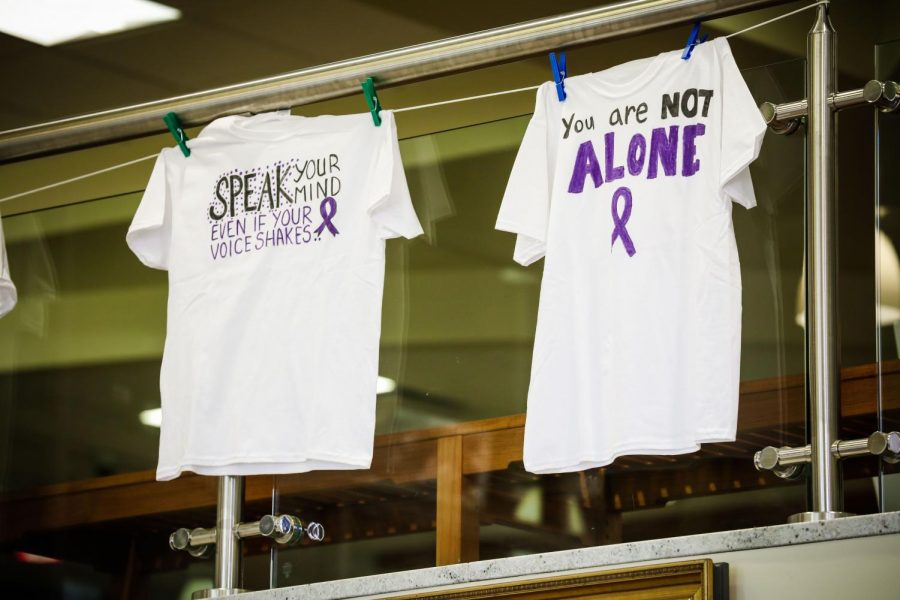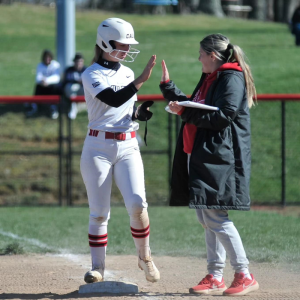Sexual Assault Exhibit
Manderino Library hosted What Were You Wearing Exhibit
Shirts of the End Violence Center’s Clothesline Project hanging in the Natali Student Center, Oct. 18, 2021. The project is a visual display that addresses the issue of domestic violence and brings awareness to its impact.
November 11, 2022
A heavy silence hung over the exhibit room as visitors moved between the displays. Outfits ranging from prom dresses, to sweatpants, to children’s sleepwear, adorned the walls, each accompanied by a single piece of paper. Every so often, a shuffle of feet would sound as someone finished with one display and moved to the next.
Beginning on Nov. 1 in PennWest California’s Manderino Library, the “What Were You Wearing?” exhibit opened to visitors. The independent project, a joint effort of students Cassidy Nodaros and Alyssa Lambert-Alonso, aimed to eliminate the misconception that the clothing of sexual assault survivors contributed to the violence they endured. The display consisted of recreations of survivor’s outfits at the time of their assault, accompanied by a written recollection of the event. These descriptions varied from detailed accounts to vague remembrances.
Nodaros, who reached out to Lambert-Alonso to start the exhibit, said that she has always been inspired to help people tell their stories and that this exhibit reflected that initiative.
“All of the stories that were displayed were from student-survivors who wanted to share their story,” Nodaros said. “I have always wanted to help people use their voices and tell their stories. Our stories and our fights make up who we are today and who we are becoming. When people are ready, I think they should have an outlet to tell their story and this exhibit gave survivors that opportunity.”
Nodaros noted that turnout at the exhibit was sizable, with students leaving nothing but positive feedback in the provided guest book and survey.
“The exhibit was full when we first opened on Tuesday,” Nodaros said. “As I sat there for the following days, there were a lot of students still coming. Some students came multiple times through the week and brought friends that did not know about the exhibit prior.”
Justine Brownfield, a first-year student who heard about the exhibit from a classmate, said that her reaction to the exhibit was mixed.
“It made me feel sad at first,” Brownfield said. “There were a lot of adult-sized clothes. Then I was angry after that because when you go around the corner, they have kids clothes on the other side. One account said that she was too young to remember the exacts of the incident. It just breaks my heart.”
Brownfield said that although she found the exhibit very moving, she thought it would be more effective if more people were aware of it.
“A lot of people like to blame victims and if more people knew what somebody was wearing at the time of the assault, I think that it would have the potential to change somebody’s opinion,” Brownfield said. “I think it would, if it reached more people. I feel like there’s always going to be a stigma around sexual assault because of how heinous it is. I don’t think that there’s going to be a way to change that. But I think more people would come if there wasn’t such a negative stigma around it.”
Nancy Skobel, associate director of the Office of Sexual Misconduct Prevention and Response, said that student-run events such as the “What Were You Wearing?” exhibit promote awareness and change perceptions in many ways.
“As an educator, I can get up in front of the class and say that one in five women will be sexually assaulted,” Skobel said. “I don’t think that has as much impact as when you see and read their stories. It changes their paradigm from a statistic to a person whose body was violated. Often times people will ask, ‘What were you wearing?’ After visiting the exhibit, people change their mind because they were not wearing clothing that was provocative.”
According to Skobel, the Office of Sexual Misconduct Prevention and Response also hosts awareness and prevention events on campus. During April, which is Sexual Assault Awareness Month, the “Take Back the Night” gathering gives survivors a place to share their stories and the “Walk a Mile in Her Shoes” event invites men to walk in high heels to raise awareness about sexual assault and to show support.
“This is not about sex, it is about power and control over another person,” Skobel said. “It happens to everyone; women, men, and children.”






